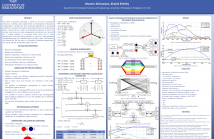
- Read more about On the Computability of the Secret Key Capacity Under Rate Constraints
- Log in to post comments
Secret key generation refers to the problem of generating a common secret key without revealing any information about it to an eavesdropper. All users observe correlated components of a common source and can further use a rate-limited public channel for discussion which is open to eavesdroppers. This paper studies the Turing computability of the secret key capacity with a single rate-limited public forward transmission. Turing computability provides fundamental performance limits for today’s digital computers.
- Categories:
 31 Views
31 Views
- Read more about Detectability of Denial-of-Service Attacks on Communication Systems
- Log in to post comments
Wireless communication systems are inherently vulnerable to adversarial attacks since malevolent jammers might jam and disrupt the legitimate transmission intentionally. Accordingly it is of crucial interest for the legitimate users to detect such adversarial attacks. This paper develops a detection framework based on Turing machines and studies the detectability of adversarial attacks. Of particular interest are so-called denial-of-service attacks in which the jammer is able to completely prevent any transmission.
- Categories:
 35 Views
35 Views
- Read more about Secure MIMO Interference Channel with Con dential Messages and Delayed CSIT
- Log in to post comments
Slide of Presentation in ICASSP 2019
- Categories:
 25 Views
25 Views
Much of security research focuses on preventing an adversary from deciphering a message's content, but there are a number of applications that motivate the more challenging goal of ``covert'' communications: transmitter Alice conveying information to legitimate receiver Bob while preventing a capable and attentive adversary Willie from detecting the presence of the message.
- Categories:
 16 Views
16 Views
- Read more about Beyond PKI: Enhanced Authentication in Vehicular Networks via MIMO
- Log in to post comments
spawc_18.pdf
- Categories:
 11 Views
11 Views
- Read more about Secrecy Capacity Under List Decoding for a Channel With a Passive Eavesdropper and an Active Jammer
- Log in to post comments
- Categories:
 11 Views
11 Views
We introduce the notion of Quality of Indicator (QoI) to assess the level of contribution by participants in threat intelligence sharing. We exemplify QoI by metrics of the correctness, relevance, utility, and uniqueness of indicators. We build a system that extrapolates the metrics using a machine learning process over a reference set of indicators.
- Categories:
 6 Views
6 Views
- Read more about DEFENDING AGAINST PACKET-SIZE SIDE-CHANNEL ATTACKS IN IOT NETWORKS
- Log in to post comments
Motivated by privacy issues in the Internet of Things systems, we generalize a proposed privacy-preserving packet obfuscation scheme to guarantee differential privacy. We propose a locally differentially private packet obfuscation mechanism as a defense against packet-size side-channel attacks in IoT networks. We formulate the problem as an optimization over a conditional probability distribution (channel) between the original and obfuscated packet sizes and show that the optimal set of obfuscated packet sizes is a strict subset of the set of original packet sizes.
- Categories:
 23 Views
23 Views- Read more about Defense against Stealthy Jammer Attacks in Wide-band Radios- A Physical Layer Approach
- Log in to post comments
- Categories:
 20 Views
20 Views
- Read more about DETERMINISTIC AND EFFICIENT THREE-PARTY QUANTUM KEY DISTRIBUTION
- Log in to post comments
The field of quantum computing is based on the laws of quantum mechanics, including states superposition and entanglement. Quantum cryptography is amongst the most surprising applications of quantum mechanics in quantum information processing. Remote state preparation allows a known state to a sender to be remotely prepared at a receiver’s location when they prior share entanglement and transmit one classical bit.
- Categories:
 16 Views
16 Views